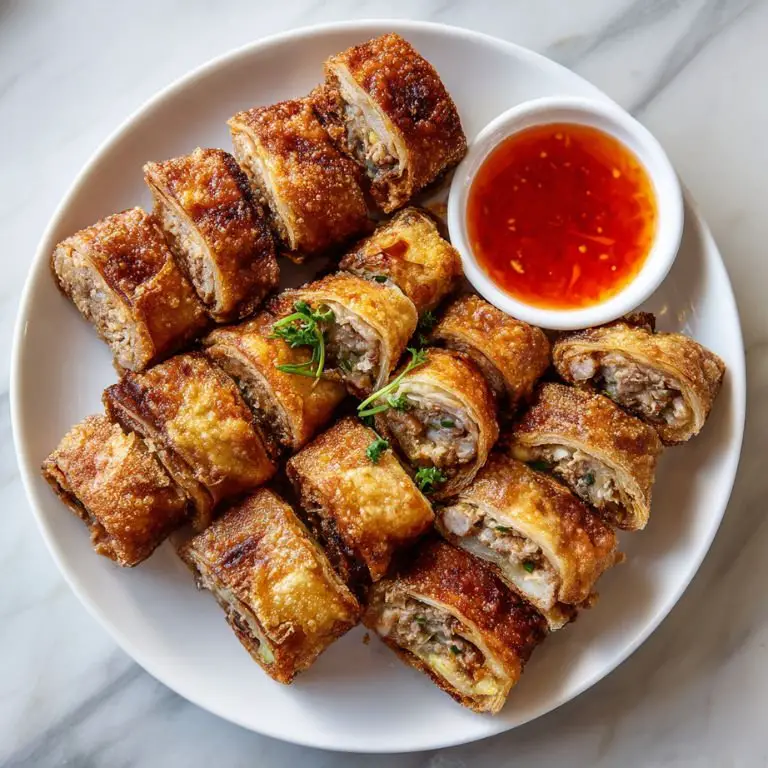Kikiam is one of those nostalgic street food favorites that immediately brings you back to afternoons spent outside school gates or weekend meriendas with family. This Crispy Fried Kikiam with Minced Pork and Bean Curd puts a homemade spin on a classic, blending the rich umami of pork with the silky texture of bean curd, all wrapped in a golden, crunchy bean curd skin. While traditional Chinese kikiam and the kikiam recipe Filipino versions vary slightly, this recipe strikes a delicious middle ground—paying homage to both roots while keeping it uniquely home-cooked and Pinoy at heart.
Whether you're exploring asian noodle recipes, looking for a side dish for your chop suey, or want a protein-packed addition to your congee recipe, this kikiam fits in perfectly. It’s also a great introduction to working with bean curd if you’ve never tried it before. And trust me, once you taste that crispy exterior and juicy filling, you’ll want to make these again and again.
Crispy Fried Kikiam with Minced Pork and Bean Curd
Prep Time 30 minutes mins
Cook Time 25 minutes mins
Total Time 55 minutes mins
Course Appetizer, Main Course
Cuisine Chinese, Filipino
Servings 6 rolls (serves 4–5 people)
Mixing bowls For combining your filling ingredients
Knife and chopping board Essential for prepping the veggies and aromatics
Steamer or large pot with a steaming rack To partially cook the rolls before frying
Tongs or slotted spoon For safe handling during frying
Non-stick skillet or deep fryer Depending on whether you want to shallow or deep fry
Kitchen towel or paper towels To drain the excess oil from fried kikiam
For the filling
- 500 g minced pork preferably with a bit of fat for juiciness
- 1/2 cup finely chopped shrimp optional but recommended for extra umami
- 1/2 cup finely diced carrots
- 1/3 cup water chestnuts or singkamas finely chopped (for crunch)
- 3 cloves garlic minced
- 1 small onion finely chopped
- 1 egg lightly beaten
- 2 tablespoons cornstarch
- 1 tablespoon oyster sauce
- 1 tablespoon soy sauce
- 1 teaspoon sesame oil
- 1/2 teaspoon ground white pepper
- 1/2 teaspoon sugar
- Salt to taste
For the wrapper
- 6 –8 sheets dried bean curd skin also known as tofu skin or yuba
- Water for softening the bean curd skin
For frying
- Cooking oil enough for shallow or deep frying
Soften the bean curd skin
Cut the sheets into rectangles (about 8x10 inches) and gently wipe with a damp cloth to soften. If the sheets are brittle, lightly moisten them with a damp towel until pliable but not soggy.
Prepare the filling
In a large bowl, combine the minced pork, chopped shrimp, carrots, water chestnuts, garlic, onion, egg, cornstarch, oyster sauce, soy sauce, sesame oil, pepper, sugar, and salt. Mix well until fully combined. The mixture should be sticky and well-bound.
Assemble the rolls
Lay out a piece of softened bean curd skin. Spoon 2–3 tablespoons of filling near one edge, then shape it into a log. Fold in the sides and roll it up like a burrito, sealing the end with a bit of cornstarch paste (just cornstarch mixed with a little water).
Steam the kikiam
Arrange the rolls in a steamer lined with parchment paper or banana leaf to prevent sticking. Steam for 15–18 minutes until cooked through and firm. Let cool to set before frying. This step ensures the inside is cooked, so the frying is just for crisping.
Fry to golden perfection
Heat oil in a pan over medium heat. Fry the kikiam rolls until golden and crispy on all sides, turning occasionally for even browning. This takes about 2–3 minutes per side. Drain on paper towels.
Pairings
Fried kikiam is incredibly versatile and works well in several serving scenarios:
- As a side dish: Pair with garlic rice and a dipping sauce like banana ketchup or sweet chili. It’s a wonderful partner for other Filipino favorites like pininyahang manok (the pininyahang manok recipe Panlasang Pinoy offers is a good match for the sweetness contrast).
- With noodles: Add sliced kikiam into a yakisoba recipe or even stir-fry with korean noodles for a unique twist. It works great as a protein topping for your go-to asian noodle recipes.
- With soup: Float slices into a bowl of congee for extra protein and texture.
- Party food: Serve with toothpicks and a dipping station. Works well alongside other pinoy food bites or even buldak carbonara for that spicy-creamy contrast.
- Bento-style lunches: Toss some slices with lightly dressed cabbage and rice for a homemade japan food vibe.
FAQs
1. Can I use a different cut of pork?
Yes, but minced pork with some fat (like from the shoulder) gives the best results. Lean ground pork will be too dry.
2. Can I skip the shrimp?
Absolutely. It adds extra flavor but isn’t essential. You can increase the pork slightly to compensate or add finely chopped mushrooms for a vegetarian-style twist.
3. Where can I find bean curd skin?
Bean curd skin (also called tofu skin or yuba) is available in most Asian groceries, usually in the dried goods or freezer section. You can also find it in online stores that specialize in hakka noodles recipe ingredients or chinese kikiam supplies.
4. Is this the same as the Chinese kikiam recipe or kikiam recipe Filipino version?
This recipe sits somewhere in the middle. The chinese kikiam often includes five-spice powder and sometimes tofu or dried squid, while the kikiam recipe Filipino version (often called "ngohiong" in Cebu) has its own twist with lumpia wrappers and more local spices. Our version uses bean curd for authenticity but keeps the seasonings balanced.
5. Can I make this ahead of time?
Definitely. You can steam the rolls ahead, refrigerate, and fry when ready to serve. They even freeze well—just thaw slightly before frying. It’s a meal prep dream!
